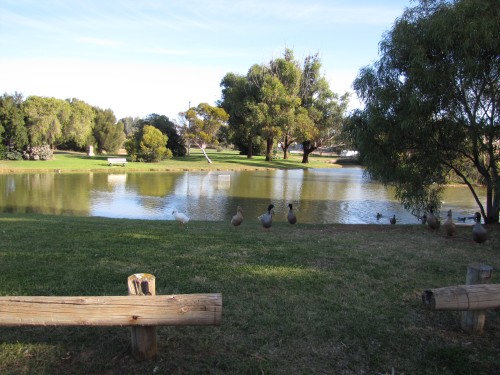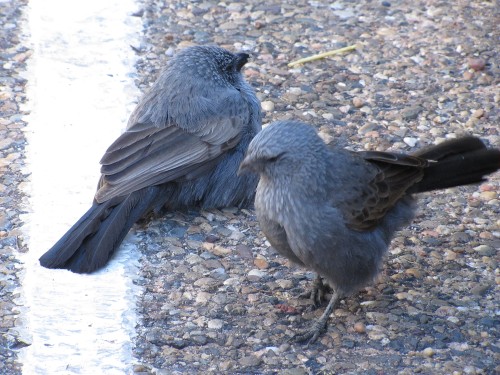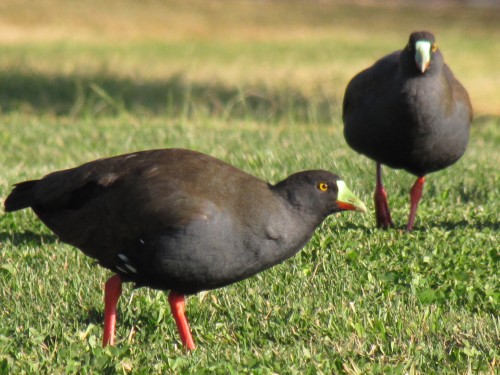A very short birding trip in Peterborough
Last week we spent several days visiting family in Peterborough in the mid-north of South Australia. The main focus of this trip was a belated Christmas family get together. My son’s family who were over from Sydney for a few weeks was the main focus, but it was also great to catch up with family members on my wife’s side of the family.
The weather was far too hot to do anything other than casual birding in the back yard. The only interesting sighting over the four days was a solitary Little Eagle soaring majestically overhead early one morning. The Peterborough area is an interesting region from a birding point of view. While many of the species seen further south are present, one can also see some of the more arid region birds around the town and in the nearby farming areas. This is about as far south as some of these arid dwelling birds venture.
One spot I always try to check out when visiting Peterborough is Victoria Park. This park, next to the town’s lovely swimming pool and caravan park features an artificial lake (see photo above). On and around this lake I have recorded quite a good range of water birds, one of the few spots in the region with enough water to sustain a small population of such species.
On this occasion we were actually on our way home. We left early to beat most of the heat of later in the day. I only drove though the park and didn’t actually stop. I guess that our visit was no longer than 2 minutes – if that. During that short time I saw the following species:
- Apostlebird
- White-winged Chough
- Australian Magpie
- Black-tailed Native-hen
- Pacific Black Duck
- Australian Wood Duck
- Mallard
- Australian Magpie Lark
- Crested Pigeon
- Galah
- Red Rumped Parrot
- Red Wattlebird
- Little Raven
It is not a long list but it does contain two interesting sightings.
Apostlebird
While Apostlebirds are quite common in the eastern parts of Australia, they are relatively rare in South Australia. They can only be seen in a handful of places. I have recorded them in the following locations:
- Taplan (SE of Loxton),
- Gladstone (mid-north of SA),
- Laura (just north of Gladstone)
- Stone Hut (just north of Laura)
- Appila (north of Gladstone)
- Peterborough (various locations around the town and district)
- Dawson Gorge (NE of Peterborough)
Several other locations have been reported by other birders in recent years. Peterborough is one of the more reliable spots for this species in South Australia. Over recent years I have seen the species in at least five spots around the town. You can read more about this species – go to the further reading section below.
Black-tailed Native-hen
On my recent visit to Victoria Park in Peterborough I saw about 5 Black-tailed Native-hens. I have seen this species on quite a few visits to this park. While the species is not rare it is unusual to see them in such a dry region as this. I suspect that these birds may actually be a resident breeding species. In some places, if the conditions are right, they can breed rapidly and within a short space of time number in the hundreds and even in the thousands. On previous visit to this park I have seen 20 – 50 birds.
Further reading:
- Apostlebirds in Peterborough
- Apostlebirds by the dozen
- Apostlebirds at Taplan in the Murray Mallee
- Apostlebirds in South Australia
Black-tailed Native-hens at Clare
A few days ago I was asked by a local courier company to deliver several urgent parcels to Clare in the mid-north of South Australia. I do the occasional emergency run for this company and enjoy getting paid to go for lovely drives in the country. The wine growing region of the Clare Valley is just over 2 hours drive from my home.
After delivering the parcels I wandered over the road to the well patronised local bakery to get some lunch. I then drove to the lake on the north eastern edge of town next to the Clare Country Club. This lake is a five minute walk from my daughter’s home and about the same from where we used to live many years ago. I couldn’t visit my daughter; she’s currently teaching in Ethiopia.
While I ate my delicious Cornish pasty I did a spot of birding, including some photography. The rest of day was mine so I could take as long as I wished getting home again. The first species to show was a large flock of abut 60 Black-tailed Native Hens, shown in the photos above and below. I haven’t seen that many together in one spot for quite a while.
Black-tailed Native-hen, Monarto Zoo, South Australia
Over recent days I have been sharing photos of some of the birds I saw during a visit late last year to the Monarto Zoo which is about a ten minute drive from our home in Murray Bridge.
During one of the bus trips through the park visitors are taken past a large lagoon. This is filled from Rocky Gully creek which flows through the zoo. I use the word “flows” loosely; it only runs after good rains and is quite often a dry creek bed for much of the year.
The zoo management has dammed this creek at one point to provide a semi-permanent water hole for the giraffes and zebra. When it contains water it attracts small numbers of water birds, including this one Black-tailed Native-hen shown in the photo above. Native-hens are widespread throughout Australia except the far northern coastline, the eastern seaboard, drier inland areas and it is also absent from Tasmania. (The similar species the Tasmanian Native-hen is endemic to Tasmania.)
It is quite unusual to see just one of this species. They are more often seen in small flocks and, when conditions are right, they can erupt into an area and breed rapidly, and can then number in the hundreds or even thousands.
Black-tailed Native-hen
On the way home from my trip to Pinnaroo in eastern South Australia last Friday I called in on the artificial lake at Lameroo. Lake Roberts is next to the caravan park and golf course on the eastern edge of town. We’ve often stopped there for lunch or morning tea on our way to the eastern states.
This lake is an average birding spot and one of the few places to observe water birds for many miles in every direction. The Murray mallee region has very few places where there is open water. I only stayed for a few minutes but still managed a nice list of birds.
- Australian Wood Duck: about 15-20 feeding on the lawn around the lake
- Little Pied Cormorant: one sitting on an exposed log
- Masked Lapwing: at least 6 feeding on the grass along the water’s edge
- Little Raven: calling from the nearby golf course
- Galah: several flying overhead
- Australian Magpie: several in trees in caravan park
- Red Wattlebird: feeding in trees near picnic tables
- Magpie Lark: 2 seen feeding along the edge of the water
- Welcome Swallow: about 12 sitting on the power lines in the main street
- Rock Dove: many seen flying near the wheat silos (the tall white structures in the photo above)
- Black-tailed Native-hen: 1 feeding on the grass
The most notable species was a solitary Black-tailed Native-hen. This bantam sized bird moves around very readily, and large numbers will suddenly appear in an area after rain or floods or in response to changing seasonal conditions. They can then disappear just as quickly. To find a solitary bird is unusual.
They are found throughout Australia where conditions suit them, usually near water, either permanent or ephemeral bodies of water. They can breed rapidly in response to good conditions and sometimes number in the hundreds (or even thousands) in a small area.
Despite being very common, and I’ve often seen them in large numbers, I don’t yet have a photo of this species. Click here to see photos and more information about them.










